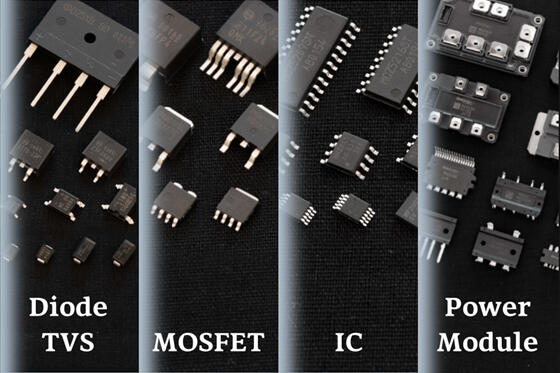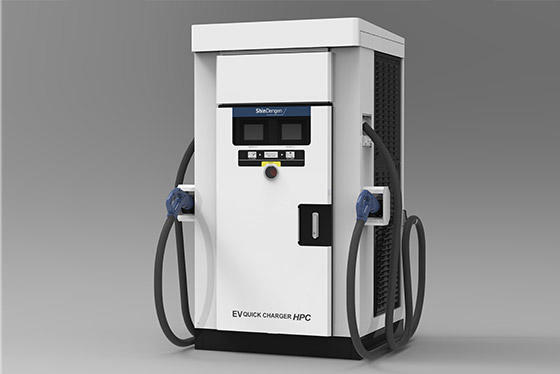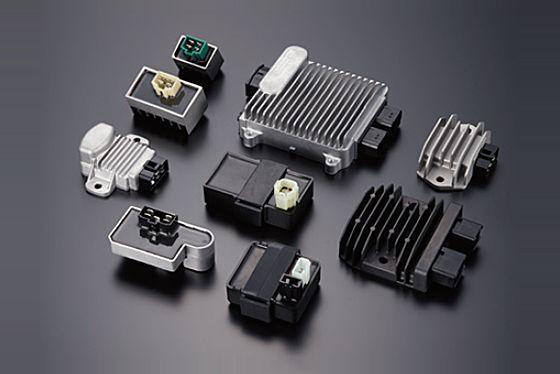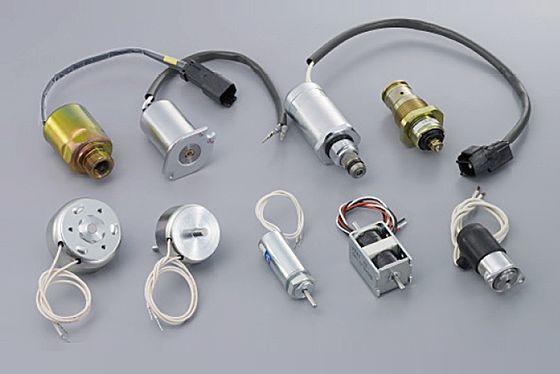Structure of Schottky barrier diodes
The diode does not use a p-n junction but a junction with a type of metal on one side and an n-type semiconductor on the other. This type of junction is called a Schottky junction.
The Schottky barrier diodes has an extremely low VF and an extremely high-speed because it does not use holes. This point could be called ideal but the reverse current IR is large, making it inappropriate as an element to withstand high voltage.
Forward bias
Reverse bias
1.VFis small ◎
The VF is extremely small compared to a diode with a p-n junction, producing high efficiency with a small forward loss.
2.Extremely high-speed ◎
There is high-speed switching without trr because there are no hole carriers.
3.Reverse current is large △
The reverse loss is larger than the p-n diode because the reverse current IR is large.
The reverse current is different depending on the type of barrier metal. The SBD can be divided further into different types according to the type of barrier metal that is used.
Differences between static characteristics among diode types
The biggest advantage of an SBD is its small VF.
However, the IR is large and therefore inappropriate as a diode to withstand high voltage.
Selecting and Using Schottky Barrier Diodes
-
-

- Trade-off between VF and IR
-
At one time, there were many diodes that focused on a low VF. There was a problem with thermal runaway (as described later) due to a large reverse current, beginning a trend away from using SBDs depending on the type of industry.
Recently, there are more low IR types being used which provide more stability even in high temperature environments.
Forward loss on SBD
When the current IF flows in a forward direction on the diode, the voltage drop VF occurs resulting in a power loss.
As indicated by the figure, the VF has negative temperature characteristics, making the forward loss smaller as the temperature becomes higher. The VF continues to become smaller virtually linear relative to the temperature.
-
-

- Example of forward characteristics on SBD
-
Reverse loss on SBD
When the voltage VR is applied in a reverse direction on the diode, the reverse current IR occurs resulting in a power loss.
As indicated by the figure, the VF has positive temperature characteristics, making the reverse loss larger as the temperature becomes higher. The IR continues to become larger exponentially relative to the temperature.
This is not a problem on the p-n diode because the IR is extremely small. However, caution must be exercised when selecting SBDs because the IR cannot be ignored on the SBD.
-
-

- Example of reverse direction characteristics on SBD
-
Relationship between temperature and loss on SBD
The forward loss decreases linearly as the temperature increases, but the reverse loss increases exponentially.
The temperature varies depending on the operating conditions of the circuit. However, it is necessary to design heat dissipation so that thermal runaway does not occur, because the loss changes to an increase at a certain temperature. If a thermal runaway occurs, the temperature continues to increase and ultimately breaks down or stops.
Thermal runaway?
-
-

- When there is more than sufficient heat dissipation, the internal heat caused by loss in the element is sufficiently dissipated.
-
-
-

- When there is limited heat dissipation, the internal heat caused by loss in the element is proportionate.
-
-
-

- When there is limited heat dissipation, that limitation makes it impossible to dissipate the large internal heat caused by loss in the element.
-
Things to consider to prevent thermal runaway
- Thermal runaway occurs even when within the guaranteed temperature range of the SBD.
- Even if thermal runaway occurs, the SBD would not necessarily break down.
- The temperature that causes thermal runaway changes depending on the operating conditions.
- The temperature that causes thermal runaway changes also depending on the heat dissipation conditions.
- Thermal runaway easily occurs because the lower the VF is, the larger the IR becomes on the SBD.
Thermal runaway susceptibility according to the SBD type
Given a switching power supply
Low VF type
There is low loss at normal temperature, however there is a big risk of thermal runaway at a high temperature.
Low IR type
There is a large loss at normal temperature but there is little risk of thermal runaway.
Types with an ultra-low VF may have a thermal runaway even when Tj = 70°C. On the other hand, types with an ultra-low IR may not be susceptible to thermal runaway even when Tj = 150°C.
Selecting and using to fit the application
- Application where reverse voltage usually does not occur, such as to prevent a reverse connection or an ORing connection
->Ultra-low VF type, low VF type - Application where reverse voltage usually occurs, such as a switching power supply
->Standard type, low IR type - Application that assumes use particularly under high temperature conditions, such as use on vehicles
->Ultra-low IR type












